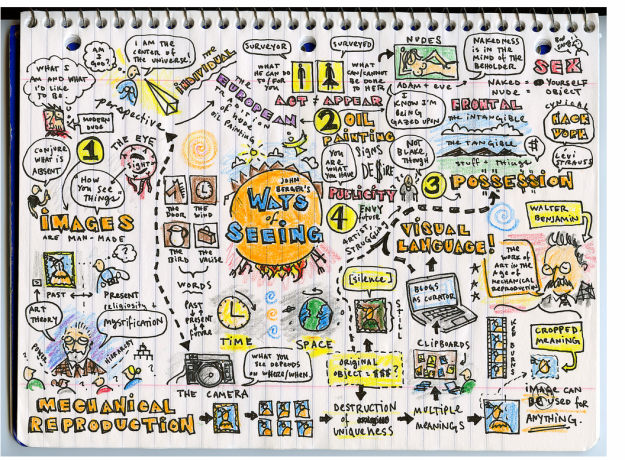I do not think, even with a million words, I could write a review of John Berger’s book “Ways of Seeing, which would be as informative or as amusing as Austin Kleon’s mind map of the book’s contents.
I bought a hard copy of the book because I was travelling and thought I could read it en route. But when I returned I watched all four episodes of the original BBC presentations which I found even better than the book (2,3,4,5). I found the typeface annoying and the images in the book unclear so the YouTube of the programmes was a more pleasing way to illuminate the book’s contents.
In the TV presentations Berger looks straight into the camera as he discusses the earliest European oil painting. These works of art were exclusively commissioned for and by rich. They exuded wealth both in their content, framing and where they hung. The content showed the rich and their possessions. The paintings were about the present. The possessors wanted to show, the world, their wealth.
When landscape became introduced into oil painting it often showed property owners in their landscape. It continued to be about the wealthy and their possessions. The poor could never aspire to ownership of any of these objects.
Berger points out that everything changed with the invention of the camera. The paintings could be reproduced and became more universally available. The camera could zoom in and out. it could isolate parts of the images which could then be used in different circumstances and loose their contact with and meaning within the original painting. We too can have a reproduction of any work of art on our pin board. Art became accessible to us all..
To protect the ‘art world’ art and to prolong the mystique around oil painting, critics and experts emerged with a language of their own. But some of the originals became extremely valuable because they were the original and the rich were prepared to pay to possess them. They had a commercial value and became commodities to be traded. We became in awe of these paintings. A whole language developed around art and art criticism and we almost forgot to look at the paintings.
Berger maintains children see more clearly than many adults. He gathered a group of children to examine a painting. Their brutally honest ‘normal’ language managed to see what many adult observers had missed, the ambiguity of the sex of one of the persons represented in the painting. We, because of our education and learning, are programmed to experience art in a certain way. We loose the spontaneity of just looking and loving or hating.
Berger then discusses the position of women in painting and advertising which I felt was somewhat misplaced in the sequence of essays. I realise the essays can be read in any order but I still felt this essay did not fit in and would have been better as a separate book. It is oviously a subject very important to Berger.
The book concludes with a discussion on ubiquitous publicity. The message is that “you can have it all if you buy this or that”. Unlike the oil painting the promise is for the future. Utopia will be ours tomorrow. Very often reproductions of oil paintings or the compositions used in them are re-used in publicity. We are receiving the ‘message’ consciously or subconsciously that we can now possess whatever we want. All we need is the means to purchase but therin lies the rub. In the programme Berger shows the women in a factory working n the Yardley’s production line where fragrances were being filled into bottles. These women were unlikely to be able to achieve the dreams offered in most advertisements in 1972, when the programme was made. Berger believed that this publicity bombardment blunts our awareness of the real state of things in the world.
I believe the situation has deteriorated even further since Berger wrote this book. The rich have got richer and the poor, poorer. Wars and unrest are ravaging our world. Meanwhile the flood of publicity continues to offer us Utopia tomorrow…..
- WAYS OF SEEING BY JOHN BERGER. 2016. WAYS OF SEEING BY JOHN BERGER. [ONLINE] Available at: http://austinkleon.com/2008/10/19/ways-of-seeing-by-john-berger/. [Accessed 15 March 2016]
- John Berger / Ways of Seeing , Episode 1 (1972) – YouTube. 2016. John Berger / Ways of Seeing , Episode 1 (1972) – YouTube. [ONLINE] Available at: https://www.youtube.com/watch?v=0pDE4VX_9Kk. [Accessed 15 March 2016].
- John Berger / Ways of Seeing , Episode 2 (1972) – YouTube. 2016. John Berger / Ways of Seeing , Episode 2 (1972) – YouTube. [ONLINE] Available at: https://www.youtube.com/watch?v=m1GI8mNU5Sg. [Accessed 15 March 2016].
- John Berger / Ways of Seeing , Episode 3 (1972) – YouTube. 2016. John Berger / Ways of Seeing , Episode 3 (1972) – YouTube. [ONLINE] Available at: https://www.youtube.com/watch?v=Z7wi8jd7aC4. [Accessed 15 March 2016].
- John Berger / Ways of Seeing , Episode 4 (1972) – YouTube. 2016. John Berger / Ways of Seeing , Episode 4 (1972) – YouTube. [ONLINE] Available at: https://www.youtube.com/watch?v=5jTUebm73IY. [Accessed 15 March 2016].

